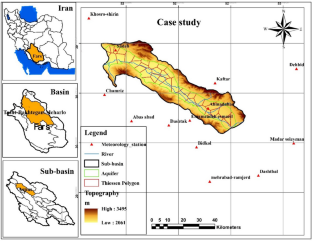Environmental Earth Sciences ( IF 2.8 ) Pub Date : 2024-04-05 , DOI: 10.1007/s12665-024-11538-w Maryam Shahbazi , Heidar Zarei , Abazar Solgi

|
Industrial and agricultural development, population increase, limitations in water resources renewability, lack of timely management of water resources, and the recent years' droughts have caused pressure on groundwater. One of the aquifers that have faced a sharp drop in water level in recent years is the Aspas aquifer in Fars province. In this study, the condition of the groundwater level (GWL) in this aquifer was analyzed using the data of the gravity recovery and climate experiment (GRACE) Satellite. In addition, pre-processing tools, such as complementary ensemble empirical mode and decomposition (CEEMD) and wavelet transform (WT), were utilized. The support vector regression (SVR) and artificial neural networks (ANN) models were used in two simple and hybrid ways with pre-processing tools. According to the results, combining the models with pre-processing tools has improved their efficiency. As a result, the coefficient of determination (R2) has been improved from 0.927 in ANN to 0.938 in W-ANN and 0.998 in CEEMD-ANN. The R2 has reached from 0.918 in the SVR to 0.949 in the W-SVR and 0.948 in the CEEMD-SVR. The comparison between the results of processing algorithms of GRACE satellite in the test phase determined that the GFZ processing algorithm shows the best performance. CEEMD-ANN performance was compared to GFZ algorithm. In addition, a new approach was utilized to forecast the GWL shifts. The results indicated that the new approach provides a suitable estimate of the groundwater in the shortest time with the lowest cost. Therefore, this approach can be used to predict the GWL in other aquifers.
中文翻译:

使用 GRACE 卫星数据和人工智能模型建模和预测地下水位的新方法(案例研究:伊朗南部的阿斯帕斯含水层)
工农业的发展、人口的增加、水资源可再生性的限制、水资源缺乏及时管理以及近年来的干旱对地下水造成了压力。近年来面临水位急剧下降的含水层之一是法尔斯省的阿斯帕斯含水层。在这项研究中,利用重力恢复和气候实验(GRACE)卫星的数据分析了该含水层地下水位(GWL)的状况。此外,还利用了互补系综经验模式和分解(CEEMD)和小波变换(WT)等预处理工具。支持向量回归(SVR)和人工神经网络(ANN)模型通过预处理工具以两种简单和混合的方式使用。根据结果,将模型与预处理工具相结合提高了效率。结果,决定系数(R 2)从 ANN 中的 0.927 提高到 W-ANN 中的 0.938 和 CEEMD-ANN 中的 0.998。 R 2已从SVR 中的0.918 达到W-SVR 中的0.949 和CEEMD-SVR 中的0.948。测试阶段GRACE卫星处理算法结果对比确定,GFZ处理算法表现出最佳性能。 CEEMD-ANN 性能与 GFZ 算法进行了比较。此外,还使用了一种新方法来预测 GWL 变化。结果表明,新方法可以在最短的时间内以最低的成本对地下水进行适当的估计。因此,该方法可用于预测其他含水层的 GWL。



























 京公网安备 11010802027423号
京公网安备 11010802027423号